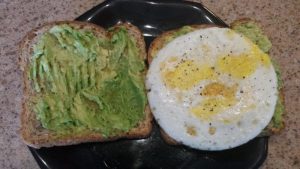23-Mar-2017
Comments Off on >Great ideas from clients
>Great ideas from clients
Category : Healthy Eating
Thanks to Denise K. this is now one of my kids’ favorite treats. Just put some grapes in a ziploc baggie and freeze them. They come out like little frozen popsicles with alot less sugar. Grown-ups like them too!
Great Suggestion #2: A substitute for ice cream
Lyn recommends this recipe from “The South Beach Diet”
Mocha Ricotta Creme
1/2 cup part-skim ricotta cheese
1/2 tsp. unsweetened cocoa powder
1/4 tsp. vanilla
1 pkg. sugar substitute
dash espresso powder
5 chocolate chips
Mix together the ricotta, cocoa powder, vanilla, and sugar substitute in a dessert bowl. Serve with a dusting of espresso powder (if you’ve got it) and the chocolate chips.
Calories: 261
Protien: 15 g
Carbohydrates: 17 g
Fat: 14 g
04-Jan-2017
Comments Off on New Year’s Resolution Success
New Year’s Resolution Success
Category : Exercise, Healthy Eating
A University of Scranton study suggests that only 8% of people achieve New Year’s Resolution Success.
How can you make 2020 a success?
- Set behavior based goals
- Track yourself on a daily/weekly basis
- Reward yourself for sticking with it
- Forgive yourself if you’re not perfect
08-Dec-2016
Comments Off on Holiday Survival Guide
Holiday Survival Guide
Category : Exercise, Healthy Eating
Get through December without putting on the pounds read our Holiday Survival Guide!
It’s hard to stick to a healthy eating and exercise plan during the holidays. Everywhere you turn there are tempting foods and drinks—from treats at the office to your traditional family favorites. When you add in a busy schedule filled with shopping and social events that make it tough to squeeze in exercise, you have a recipe for disaster as far as your scale is concerned.
Read Holiday Survival Guide
20-Oct-2016
Comments Off on Healthy Strong Skeleton
Healthy Strong Skeleton
Category : Active Living, Healthy Eating
Do you have a healthy strong skeleton?
If you are a woman, you have a 50/50 chance of suffering a fracture related to osteoporosis according to the National Institutes of Health. As for men, one in eight are expected to fracture a bone due to this disease. Osteoporosis affects women more than men because women have less bone mass and begin to lose bone at a younger age.
Are you at risk for osteoporosis?
Some risks are beyond your control such as being female, post-menopausal & Caucasian. Women can lose 20 percent of their bone density during the 5-7 years following menopause. Beginning at menopause women should have their bone density checked every two years.
Men in their fifties do not experience the rapid loss of bone mass that women do, however, by age 65 or 70, men and women lose bone mass at the same rate. Whether you are a man or woman your lifestyle is very important to your skeleton’s health. You can reduce your risk with appropriate exercise and diet; not to mention smoking cessation.
Exercise for a healthy strong skeleton
The muscles and tendons attached to the bones pull on them stimulating them to produce more bone cells. The best exercises for prevention of osteoporosis are those described as “weight-bearing”: walking, running, aerobic dance and weight training. In fact, “high-impact” exercises such as running and jumping are very beneficial if you are fit enough to do these activities without injuring yourself. Non-impact exercise such as biking and swimming will not help with bone density. Keep in mind that only the bones being stressed will get stronger, so performing an exercise such as running will strengthen the bones in your lower body, however your upper body will still require some attention.

What if you already have been diagnosed with osteoporosis?
Many people are afraid to exercise once they have been diagnosed with osteoporosis because they are concerned that exercise may cause a fracture. However, exercise can be very beneficial even after diagnosis. MayoClinic.com recommends three kinds of exercise: 1) strength training to improve your posture; 2) low-impact aerobic exercises such as walking, elliptical trainer and step aerobics; and 3) flexibility exercises to improve your posture and balance. Those with osteoporosis should avoid high-impact exercises (such as jumping or running) as well as exercises which require bending forward or twisting at the waist such as touching your toes, using a rowing machine, golf, tennis, bowling and some yoga and Pilates movements. Be sure to get your doctor’s approval before you begin an exercise program.
Eating for a healthy strong skeleton
Caffeine, alcohol, sugar and salt cause more calcium to be lost than absorbed. Also, a diet high in animal protein can contribute to bone loss because animal protein leaches calcium from the bones. A series of studies from the Cornell-China-Oxford Project on Nutrition, Health and Environment, by nutritional biochemist T. Colin Campbell and his colleagues, suggests that increased levels of animal-based proteins, including protein from dairy products, “almost certainly contribute to a significant loss of bone calcium while vegetable-based diets clearly protect against bone loss”.
A conservative interpretation of the report is that you definitely shouldn’t increase animal protein intake to get your calcium. In other words, don’t add several glasses of milk per day to your current diet. Instead, replace low calcium protein sources with high calcium protein sources such as: beans (navy, white, soy & black-eyed peas), fortified breakfast cereals, soy products (tofu, soy-based beverages), calcium-fortified orange juice, and some dark green leafy vegetables (collard greens, turnip greens, bok choy, mustard greens).

Calcium & Vitamin D
Getting enough calcium, whether through diet, supplements, or both, is essential to maintaining bone strength and can prevent osteoporosis-related fractures. Vitamin D plays a major role in calcium absorption and bone health. The National Osteoporosis Foundation (NOF) recommends adults under age 50 need 1,000 mg of calcium daily and 400-800 IU of Vitamin D. For adults age 50 and over 1,200 mg of calcium daily and 800-1000 IU vitamin D are recommended.
Be good to your skeleton and give it the exercise and nutrients it needs to stay healthy and support you throughout your life. I hope you and your skeleton have a fun and safe Halloween! –Karin.
08-Oct-2016
Comments Off on Halloween Candy vs. Burpees
Halloween Candy vs. Burpees
Category : Healthy Eating
It’s the second week of October,
stores are well-stocked with trick-or-treat candy,
but does that mean you need to stock your pantry?!
Be realistic, if you buy Halloween candy now will it actually be around on October 31st when the kids come knocking?
Leave the candy in the store until just a few days before Halloween….
otherwise, stepping on the scale might get a little scary!

Burpee Calculator source: saratogamama.com
This might help put things in perspective…you love burpees, right?
13-Sep-2016
Comments Off on How Skinny is your Kitchen?
How Skinny is your Kitchen?
Category : Healthy Eating
Is your kitchen helping or hurting your weight-loss efforts?
Did you know that the average woman who keeps a box of breakfast cereal visible anywhere in her kitchen weighs about 21 pounds more than her neighbor who doesn’t? How about that having potato chips or crackers in plain sight causes you to weigh 8 pounds more than your neighbor who puts them out of sight (or better yet don’t keep them in the house!)
Recently I read an article by Brian Wansink, PhD author of “Slim by Design: Mindless Eating Solutions for Everyday Life”. In his book he provides a 100-point checklist to evaluate your kitchen. However in the spirit of “taking baby-steps” and not trying to change everything at once I wanted to start by sharing the 10-point checklist he offers in his article “Food-Related Behavior Change Made Easy”.
How many of the following are true in your home?
- Salad and vegetables are served first before the entrée and starches are brought to the table.
- The main dish is pre-plated and served from the stove or counter (not family style).
- Your dinner plates are 9-10 inches in diameter.
- You eat sitting at a table with the TV turned off.
- There are two or fewer cans of soft drinks in your refrigerator at any one time. (Doesn’t matter if it’s diet or regular soda).
- Your kitchen counters are organized (not messy).
- Precut fruits and vegetables are now on your middle refrigerator shelf.
- At least 6 single servings of protein are in your fridge: Hard-boiled eggs, yogurt, string cheese, tofu, etc.
- Your snacks are kept in one inconveniently located cupboard.
- The only food on your kitchen counter is a fruit bowl.
How many did you check? If you checked seven or more, congratulations, you’re doing great. If you scored less than seven which ones can you change in the next week?
You eat what you see first, so the ONLY food that should be on your kitchen counter is a fruit bowl!
P.S. Learn more about Dr Wansink’s book “Slim by Design: Mindless Eating Solutions for Everyday Life” at www.slimbydesign.org
20-Jul-2016
Comments Off on Avocado Toast
Avocado Toast
Category : Healthy Eating
I was very surprised to learn from a client (who travels a whole lot more than I do) that avocado toast is “a thing” on both coasts and here in the mid-west we’re missing out!! I accidentally invented avocado toast (for myself) years ago because it’s a great substitute for some less desirable condiments such as mayo or butter.
Please, don’t worry about how many calories are in an avocado. The health benefits of the avocado far outweigh any concern you may have about the fat content… it’s monounsaturated fat which is “heart healthy” plus a little fat goes a long way toward helping you feel full longer so you will actually consume less calories throughout the day.
What’s so great about avocado?
- They have more potassium than bananas
- They are high in monounsaturated oleic acid, a “heart healthy” fatty acid that is believed to be one of the main reasons for the health benefits of olive oil.
- A 100 gram (3.5 ounce) serving of avocado contains 7 grams of fiber, which is 27% of the recommended daily amount.
- Numerous studies have shown that eating avocado can improve heart disease risk factors like Total, LDL and HDL cholesterol, as well as blood triglycerides.
- Avocados are high in antioxidants, including Lutein and Zeaxanthin. These nutrients are very important for eye health and lower the risk of macular degeneration and cataracts.
- They are rich in vitamins and minerals, such as B-vitamins, vitamin K, potassium, copper, vitamin E and vitamin C.
19-Jan-2016
Comments Off on Protein Quality and Quantity
Protein Quality and Quantity
Category : Healthy Eating
I’ve been a big advocate of protein over the years and have written plenty of articles about the benefits of protein and how to get more protein into your diet. There’s always more to learn though, so I wanted to share what I recently read in this month’s IDEA Fitness Journal called “Tapping the Power of Protein” by Christopher R. Mohr, PhD, RD. This article emphasizes eating high quality protein at least three times per day.
Here’s what I learned:
Be sure to eat protein throughout the day, but particularly at breakfast.
Americans tend to eat most of their protein later in the day, however we should really be eating in for breakfast. According to Stewart Phillips, PhD and professor at McMaster University, “It’s a good idea to aim for around 20 g of protein if you’re younger or 30-40 g if you’re older.” Also, in a 12-week study conducted by Heather Leidy, PhD, an assistant professor at the University of Missouri it was discovered that a high protein breakfast (35 g of protein) reduced daily hunger and led to voluntary reductions of about 400 calories in daily food intake.
Also, not all protein is created equal…
I learned about an amino acid called leucine. When this amino acid is present muscle protein synthesis will occur. So which foods that are high in leucine? IDEA fitness journal’s article mentions the following: cottage cheese, chicken breast, ground beef, wild salmon, whole egg. I searched online for more options because I felt that list was very limited for vegetarians. Here are some good choices: soybeans, pumpkin seeds, peanuts, and white beans. The goal is to eat 2.2-3 g of protein with each meal.
14-Jul-2015
Comments Off on When to buy Organic
When to buy Organic
Category : Healthy Eating
This is great time of year to buy fresh produce…But the burning question is: When to buy organic?
A nonprofit organization call the Environmental Working Group looked at 51,000 pesticide tests for 53 popular fruits and vegetables and then ranked them based on how much and how many different pesticides were found. The Dirty Dozen is their list of the 12 foods shown to have the highest levels. Whenever possible, buy the organic versions of these 12 fruits and vegetables.Dirty Dozen
Apples
Strawberries
Grapes
Celery
Peaches
Spinach
Sweet Bell Pepper
Imported Nectarines
Cucumbers
Cherry Tomatoes
Imported Snap Peas
Potatoes
Giving credit where credit is due: This information adapted from an article by Dr. Mark Roussell PhD26-May-2015
Comments Off on Avoid Weekend Weight Gain
Avoid Weekend Weight Gain
Category : Healthy Eating
- Group 1 (diet group) took in 20% fewer calories each day but didn’t change their activity level.
- Group 2 (exercise group) increased their daily exercise regimen but didn’t change their diet, to have a comparable energy deficit as Group 1.
- Group 3 (control group) did not change their diet or activity level.
- Eat before you go grocery shopping Many people do their week’s grocery shopping on Saturday or Sunday, do not go to the store hungry or you will most certainly put things in your cart on impulse.
- Keep healthy snacks on handy in the car Whether you are traveling or running errands, carrying a healthy snack will keep you out of the drive-thru lane.
- Keep a food journal A journal will make you more mindful of what you are putting into your mouth. A recent study found that food journaling actually doubled weight-loss efforts!
- Limit eating out Try to avoid fast food all together. If you do eat out remember to eat reasonable portions and eat all your vegetables.
- Limit your alcohol consumption There are a lot of empty calories in alcohol. It also reduces your inhibitions to eat junk food AND makes you feel hungrier.
- Plan to get some exercise Schedule in exercise either one or both days. If you are away from home and no equipment is available simply put on your walking shoes and get moving!
- Which tactics above did you try? Did they work?
- What did you do well?
- Ask yourself: What can you do better next weekend?







